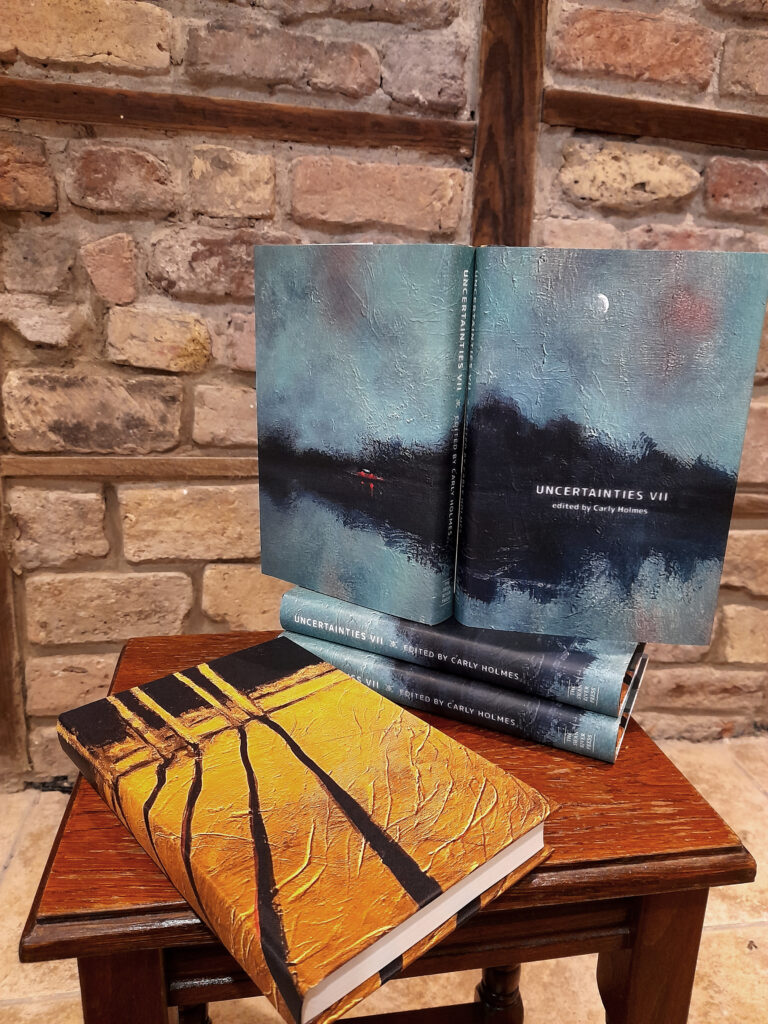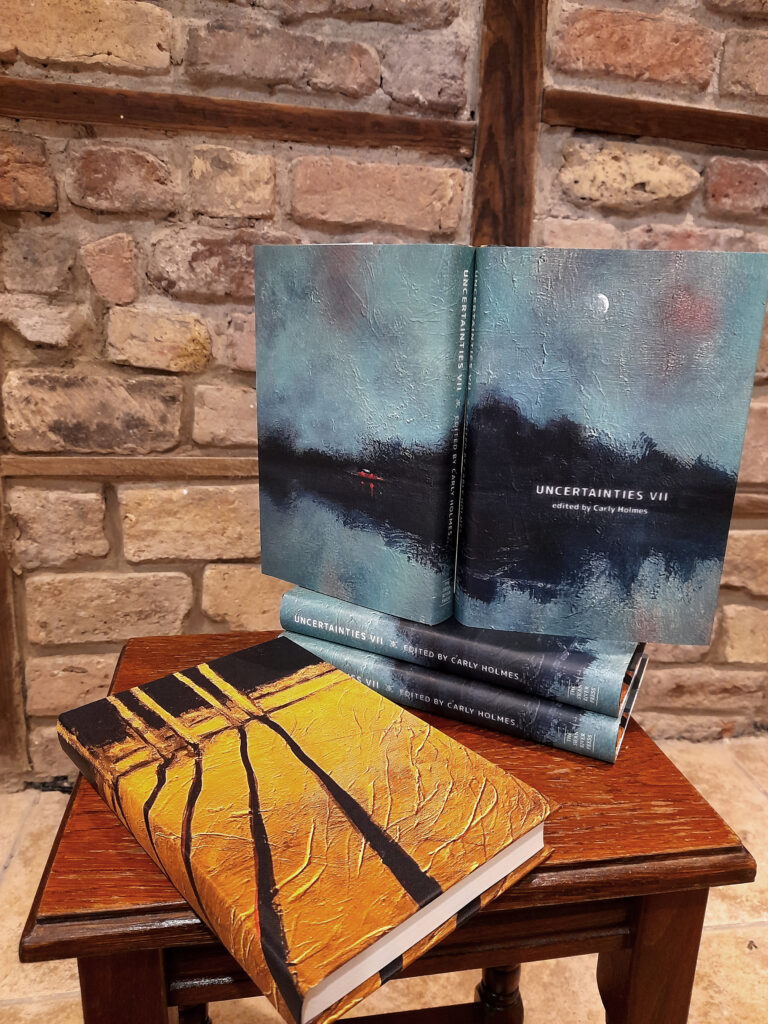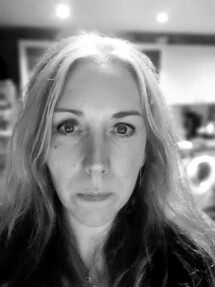Uncertainties 7
Carly Holmes (ed.)
Availability: In Print – Hardback
“It came out of the dark, and into the dark it has gone again.” – E. F. Benson
“Ghost stories,” as Elizabeth Bowen observed, “are not easy to write—least easy now, for they involve more than they did.” But these eleven writers take up the challenge, each in their own way, with expert awareness of the genre’s limitless possibilities.
Uncertainties is an anthology series—featuring authors from Wales, England, Germany, Canada, and the United States—each exploring the concept of increasingly fragmented senses of reality. These types of short stories were termed “strange tales” by Robert Aickman, called “tales of the unexpected” by Roald Dahl, and known to Shakespeare’s ill-fated Prince Mamillius as “winter’s tales”. But these are no mere ghost stories. These tales of the uncanny grapple with existential epiphanies of the modern day, when otherwise familiar landscapes become sinister and something decidedly less than certain . . .
- Craig Rosenberg’s “The Good Old Day” was shortlisted for an Aurealis Award 2024.
Hardback edition limited to 425 copies.
Cover art by James F. Johnston
Selected by Carly Holmes
ISBN: 978-1-78380-050-6 (hbk)
Contents
“Foreword” – Carly Holmes
“Pond Scum” – Tyler Keevil
“An Innocent Beast” – Georgina Bruce
“Mama Fungus” – Sarah Read
“Sad Face” – Mark Morris
“The Winding of the Willows” – Steve Toase
“Subject Matter” – Philippa Holloway
“A Suit of Darkest Blue” – Steven J. Dines
“Little Nothings” – Premee Mohamed
“Ends Abruptly” – Tim Major
“The Son” – Bethany W. Pope
“The Good Old Days” – Craig Rosenberg
“An Empty House” – Jessica Hagy
“Contributor Notes”
Carly Holmes
Carly Holmes is a writer and editor who lives on the west coast of Wales. She is the author of the novels The Scrapbook, which was shortlisted for the International Rubery Book Award, and Crow Face, Doll Face. Her short story collection Figurehead was published by Tartarus Press. She has had numerous stories published in journals and anthologies, and has been selected for The Best Horror of the Year three times.
Read more“In her choice of stories for this collection, Holmes demonstrates clearly that the genre of the uncanny is in rude health. Highly recommended.” – You’re Reading

Uncertainties Volume 7 selected by Carly Holmes; cover art (“Detour”) by James F. Johnston; cover design by Meggan Kehrli; edited by Brian J. Showers and Timothy J. Jarvis; copyedited by Jim Rockhill; typeset by Steve J. Shaw; published by Swan River Press at Æon House.
First Hardback Edition: Published on 11 November 2024; limited to 425 copies, the first 100 of which are embossed and hand-numbered; dust jacketed; illustrated cloth-printed boards; endpapers (Wibalin Maroon WBN534); ix + 220 pages; lithographically printed on 90 gsm cream paper; sewn binding; head- and tail-bands (Winterband 382 maroon); printed by TJ Books; ISBN: 978-1-78380-050-6.

 “In an Uncertain Mode”
“In an Uncertain Mode”
Conducted by Brian J. Showers
For most of our books we conduct short interviews just prior to the title’s release. In the case of an anthology, the interview is with the editor. For Uncertainties 7, I wanted to do something slightly different. Hoping for just a bit more insight into the genre we love, I posed a single question:
What draws you to write tales in the weird/uncanny mode?
Here are the responses . . .
Tyler Keevil (“Pond Scum”)
I often think of this type of writing in photographic terms; it’s akin to viewing our material through a tinted (or tainted) lens. The result isn’t purely “realistic” and it isn’t meant to be. It allows us to manipulate the mood and tone of what we’re depicting: to enhance certain elements, to reveal different truths, to expose areas that might otherwise go unnoticed.
Georgina Bruce (“An Innocent Beast”)
I’m drawn to the weird and uncanny because there is a huge gap between reality and our perception of reality, and the things that live in that gap only respond to metaphor. Straightforward exposition sends them scattering into dark corners, but you can lure them out with a weird image or a nice little tidbit of poetry.
Sarah Read (“Mama Fungus”)
The world has always felt weird and uncanny to me. Not in a bad way, although there are times where my wonder tips into fear. I like standing right on the border of those two—wonder and fear—when it comes to the way I experience story. I find the sense of insignificance that cosmic horror gives me to be comforting, not terrifying, and I like tapping into that cosmic sense on a smaller scale. Microcosmic horror, if you will. Elder gods are very impressive, sure, but have you ever seen an ant’s face up close? I guess what draws me to weird and uncanny stories is that they feel more true. The world is weird. If the story isn’t weird, I sense deception.
Mark Morris (“Sad Face”)
I’ve always been attracted to the weird, the uncanny, the numinous, the creepy, and although I think there are multiple answers as to why, it can probably be boiled down into two main reasons. Firstly, the idea that there is more to this world (and beyond it) than we currently understand, I find thrilling, both instinctively and intellectually. And secondly, I feel mentally invigorated by new and startling ideas and images; I have a constant urge (in a fictional sense) to encounter things I’ve never encountered, or even imagined, before.
Steve Toase “The Winding of the Willows”
For me, at the heart of the weird is the idea that the world is not as we see it. What we experience in the everyday is a façade and in weird fiction that façade cracks. The reason why I am attracted to the weird as a story form, is because I truly believe life is like that. The world I see is not the world out there, and I need glasses to access reality. I hear things that do not exist (tinnitus rather than something ancient and unknowable). The way our perception changes throughout our lives is similar to how the protagonist in a weird fiction story sees their understanding shift. Most of us have experienced the feeling of the floor dropping away when we find out a relationship was different to how we saw it, or the apocalyptic tsunami of grief, and how the world will never be the same. For me, these sensations and emotions can all be explored so beautifully, without hesitation, through uncanny and weird fiction. It feels like my home, because, in truth, it reflects the reality we experience every day.
Philippa Holloway (“Subject Matter”)
My writing has always been rooted in observation, defamiliarisation, and questioning . . . the closer I look, the weirder the world is revealed to be. Writing in the uncanny mode, exploring the space between concrete reality and psychology and perception, allows me to ask more complex and deeper questions of the world I experience.
Steven J. Dines (“A Suit of Darkest Blue”)
I’m drawn to writing fiction that deals with dark and often uncomfortable truths. Weird/uncanny fiction is, oddly enough, a natural fit for me in that respect, particularly when I want to write about extreme mental states, such as loss and grief, confusion and fear.
Premee Mohamad (“Little Nothings”)
I think what draws me to the uncanny/weird fiction is the sense it often gives me of being so much more connected to a kind of larger or collective unconsciousness than other types of writing. To me it seems like the only possible translation of dreams, or the life of dreams, into a dreamlike but accessible form—I’m thinking of the times I’ve run across something in a Clive Barker or Jeff VanderMeer novel that makes me jump because I’m sure I’ve seen it in a dream. And as an author I love the challenge of trying to veer away from strict surrealism or absurdism and into something that has its own rules and consequences, strange though they may be.
Tim Major (“Ends Abruptly”)
I think it’s because consciousness itself is weird. Our understanding of ourselves is full of holes and inconsistencies, and we merge invented images with those drawn from the world around us. In our memories we skip over objective facts and dwell on subjective aspects. Weird fiction amps up emotional, subjective responses in a similar way.
Bethany W. Pope (“The Son”)
Horror stories, tales of the uncanny, weird fiction: these genres treat subjects which are objects of psychological fact but which cannot be depicted believably in a more “realistic” mode. You are unlikely to encounter, in your everyday life, a being powerful enough to enact world-ending actions. On the other hand, you are incredibly likely to encounter people who can, and will, do their damnedest (I chose that word intentionally) to devastate your own small life. Monstrous hubris, callousness, selfishness all skulk about in human skin. These stories are valuable, both because of the negative hope they imply (if demons are real, there must also be angels) and also because they capture feelings which all of us encounter, but which cannot possibly be written about if the setting is a sunlit, middle-class living room in which no form of magic could ever be possible. Also, frankly, they’re fun as hell. Aside from the psychological value of these stories, they provide the same thrills (the same release) as a really scary roller coaster. Who could say no to that?
Craig Rosenberg (“The Good Old Days”)
Returning from a rafting trip in Oregon, I landed in LAX with my wife and two boys and headed through the labyrinthine airport towards the baggage claim when my oldest son, 11, spotted a sign at a take-out store—“sammwiches”. He pointed at it and told me they had spelled “sandwich” incorrectly. I shook my head and assured him they had spelled it correctly. His face screwed up with confusion. His younger brother piped up in support, “I think you’re wrong, Dad.” My wife, always ready for mischief, joined in and confirmed that “sammwiches” was indeed the correct spelling. The boys looked at each other. “Huh.” “Or what if,” I suggested, “we’ve landed on some parallel Earth? And they spell things differently here? What if we just saw a little hint of the truth? What if they call airports ‘cloud transport’? And what if everyone here has different names than on our Earth? Wouldn’t that be weird, Robert?” My son’s name isn’t Robert, but the moment I said it, the two boys’ eyes widened, their imagination ignited. They looked anew at the world. The entire ride home, they searched the outside world for evidence that we had landed on a parallel Earth—that man on the corner, doesn’t he have a third hand hiding in his sleeve? Didn’t that car just float in the air? Was that a three-eyed alien standing at the newspaper stand? We returned home to our normal life, invigorated. This is why I’m drawn to weird stories: they transform the world around us, hint that behind our normal, everyday, routine life there is something more mysterious, ominous, unknowable.
Jessica Hagy (“An Empty House”)
The uncertainty is in unhidden unknown. It’s in the problems unspoken and worn as wrinkles on faces. It’s in the ancient ghosts that aren’t hiding in shopping mall parking lots. It’s in the foreboding feeling in the fog. The uncertainties are in the pile of glass left on the sidewalk after the car crash. The elements that unnerve or itch, those are the clues that the uncanny is waiting to be noticed. We’re encouraged to ignore the weirdness all around us as and act as if everything makes sense and fits together. But when we catch that whiff of the odd, that edge of the uncanny, all the normalcy falls away and we realise that everyone is a freak and every place is a portal into absurdity.
James F. Johnston (“Detour”)
I nearly always start without a plan, and the emerging subject often feels more like an act of excavation. The result is often a surprise or an unlikely combination of things that are in my mind, paintings or places I’ve seen, deep down anxieties, or stuff that’s a bit more buried. Maybe that’s why the resulting pictures have that “uncanny” or “weird” feel to them, and often a combination of unsettling, and hopefully, beautiful. The unanswered nature of open narratives definitely adds a strangeness to art that I like, something that’s happening between actions, unexplained and ambiguous.
Read an interview with editor Carly Holmes.









